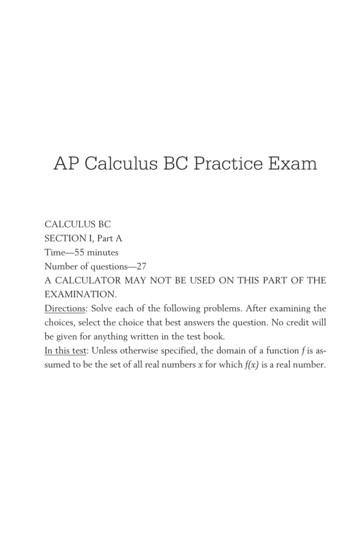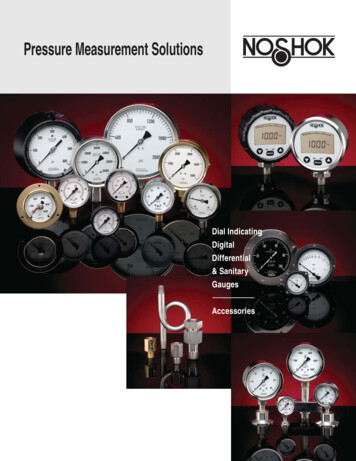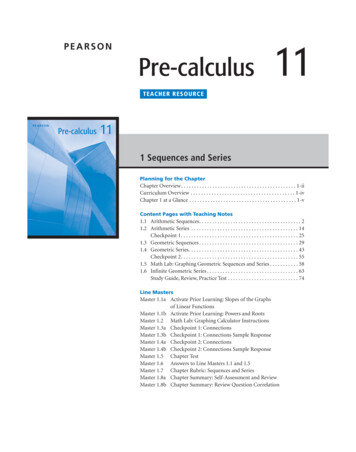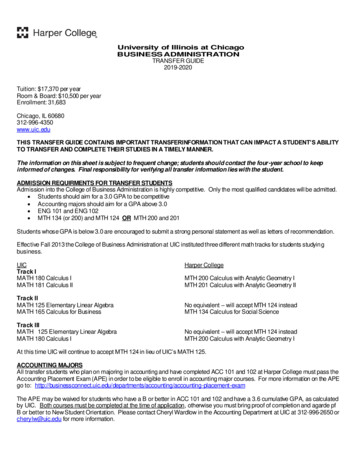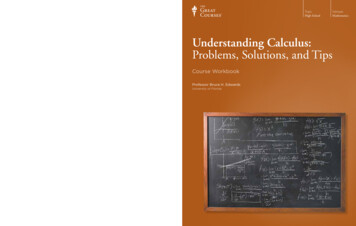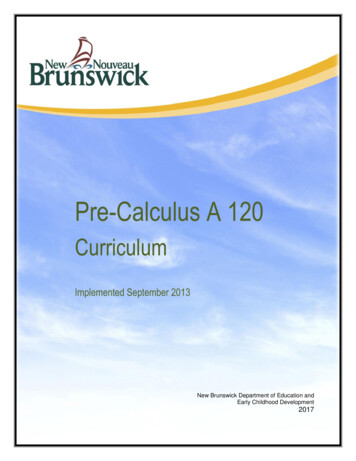
Transcription
Pre-Calculus A 120CurriculumImplemented September 2013New Brunswick Department of Education andEarly Childhood Development2017
AcknowledgementsThe New Brunswick Department of Education and Early Childhood Development gratefully acknowledgesthe contributions of the following groups and individuals toward the development of the New BrunswickPre-Calculus A 120 Curriculum Guide: The Western and Northern Canadian Protocol (WNCP) for Collaboration in Education: The CommonCurriculum Framework for Grade 10-12 Mathematics, January 2008. New Brunswick Pre-Calculus A120 curriculum is based on Outcomes and Achievement Indicators from WNCP Pre-Calculus Grade12. Reproduced (and/or adapted) by permission. All rights reserved. Newfoundland and Labrador Department of Education, Prince Edward Island Department of Educationand Early Childhood Development. The NB High School Mathematics Curriculum Development Advisory Committee of Bev Amos,Roddie Duguay, Suzanne Gaskin, Nicole Giberson, Karen Glynn, Beverlee Gonzales, Ron Manuel,Stacey Leger, Jane Pearson, Elaine Sherrard, Alyssa Sankey (UNB), Mahin Salmani (UNB), MaureenTingley (UNB), Gouhua Yan (UNB). The NB Grade 12 Curriculum Development Writing Team of Carolyn Campbell, Mary Clarke, GailCoates, Megan Crosby, Richard Cuming, Geordie Doak, Nancy Everett, Ryan Hachey, NancyHodnett, Wendy Hudon, Wendy Johnson, Julie Jones, Andrea Linton, Brad Lynch, Erin MacDougall,Sheridan Mawhinney, Chris McLaughlin, Nick Munn, Yvan Pelletier, Parise Plourde, Tony Smith, AnneSpinney, Glen Spurrell. Martha McClure, Learning Specialist, 9-12 Mathematics and Science, NB Department of Education The Mathematics Learning Specialists, Numeracy Leads, and Mathematics teachers of NewBrunswick who provided valuable input and feedback throughout the development and implementationof this document.
Table of ContentsCurriculum Overview for Grades 10-12 Mathematics . 1BACKGROUND AND RATIONALE . 1BELIEFS ABOUT STUDENTS AND MATHEMATICS LEARNING . 2Goals for Mathematically Literate Students . 2Opportunities for Success . 3Diverse Cultural Perspectives . 3Adapting to the Needs of All Learners. 4Universal Design for Learning . 4Connections across the Curriculum . 4NATURE OF MATHEMATICS . 5Change . 5Constancy . 5Patterns . 6Relationships . 6Spatial Sense . 6Uncertainty . 7ASSESSMENT . 7CONCEPTUAL FRAMEWORK FOR 10-12 MATHEMATICS . 9Communication [C] . 10Problem Solving [PS] . 10Connections [CN] . 11Mental Mathematics and Estimation [ME] . 11Technology [T] . 12Visualization [V] . 12Reasoning [R] . 13ESSENTIAL GRADUATION LEARNINGS .14PATHWAYS AND TOPICS .15Goals of Pathways . 15Design of Pathways . 15Instructional Focus . 16SUMMARY .17CURRICULUM DOCUMENT FORMAT .18
Specific Curriculum Outcomes . 19Relations and Functions .20RF1: Demonstrate an understanding of the effects of horizontal and vertical translations onthe graphs of functions and their related equations. . 20RF2: Demonstrate an understanding of the effects of horizontal and vertical stretches onthe graphs of functions and their related equations. . 23RF3: Apply translations and stretches to the graphs and equations of the functions. . 26RF4: Demonstrate an understanding of the effects of reflections on the graphs of thefunctions and their related equations, including reflections through the 𝒙-axis, 𝒚-axis,line 𝒚 𝒙. . 29RF5: Demonstrate an understanding of inverses of relations. . 34RF6: Graph and analyze radical functions (limited to functions involving one radical). . 37RF7: Demonstrate an understanding of exponential functions. 42RF8: Demonstrate an understanding of logarithms. . 46RF9: Graph and analyze exponential and logarithmic functions . 50RF10: Demonstrate an understanding of the product, quotient and power laws oflogarithms. . 53RF11: Solve problems that involve exponential and logarithmic equations. . 55Trigonometry .61T1: Demonstrate an understanding of angles in standard position, expressed in degreesand radians. . 61T2: Develop and apply the equation of the unit circle. . 67T3: Solve problems, using the six trigonometric ratios for angles expressed in radians anddegrees. . 72T4: Graph and analyze the trigonometric functions sine, cosine and tangent to solveproblems. . 78T5: Solve, algebraically and graphically, first and second degree trigonometric equationswith the domain expressed in degrees and radians. . 78T6: Prove trigonometric identities, using reciprocal identities, quotient identities,Pythagorean identities, sum or difference identities (restricted to sine, cosine andtangent), double-angle identities (restricted to sine, cosine and tangent). . 80SUMMARY OF CURRICULUM OUTCOMES. 85REFERENCES. 86
Curriculum Overview for Grades 10-12 MathematicsCurriculum Overview for Grades 10-12 MathematicsBACKGROUND AND RATIONALEMathematics curriculum is shaped by a vision which fosters the development of mathematically literatestudents who can extend and apply their learning and who are effective participants in society.It is essential the mathematics curriculum reflects current research in mathematics instruction. Toachieve this goal, The Common Curriculum Framework for Grades 10–12 Mathematics: Western andNorthern Canadian Protocol has been adopted as the basis for a revised mathematics curriculum inNew Brunswick. The Common Curriculum Framework was developed by the seven ministries ofeducation (Alberta, British Columbia, Manitoba, Northwest Territories, Nunavut, Saskatchewan andYukon Territory) in collaboration with teachers, administrators, parents, business representatives, postsecondary educators and others.The framework identifies beliefs about mathematics, general and specific student outcomes, andachievement indicators agreed upon by the seven jurisdictions. This document is based on bothnational and international research by the WNCP and the NCTM.There is an emphasis in the New Brunswick curriculum on particular key concepts at each grade whichwill result in greater depth of understanding and ultimately stronger student achievement. There is alsoa greater emphasis on number sense and operations concepts in the early grades to ensure studentsdevelop a solid foundation in numeracy.The intent of this document is to clearly communicate high expectations for students in mathematicseducation to all education partners. Because of the emphasis placed on key concepts at each gradelevel, time needs to be taken to ensure mastery of these concepts. Students must learn mathematicswith understanding, actively building new knowledge from experience and prior knowledge (NCTMPrinciples and Standards, 2000).Page 1PRE-CALCULUS A 120
Curriculum Overview for Grades 10-12 MathematicsBELIEFS ABOUT STUDENTS AND MATHEMATICS LEARNINGThe New Brunswick Mathematics Curriculum is based upon several key assumptions or beliefs aboutmathematics learning which have grown out of research and practice. These beliefs include: mathematics learning is an active and constructive process; learners are individuals who bring a wide range of prior knowledge and experiences, and who learnvia various styles and at different rates; learning is most likely to occur when placed in meaningful contexts and in an environment thatsupports exploration, risk taking, and critical thinking and that nurtures positive attitudes andsustained effort; and learning is most effective when standards of expectation are made clear with on-going assessmentand feedback.Students are curious, active learners with individual interests, abilities and needs. They come toclassrooms with varying knowledge, life experiences and backgrounds. A key component insuccessfully developing numeracy is making connections to these backgrounds and aspirations.Students construct their understanding of mathematics by developing meaning based on a variety oflearning experiences. This meaning is best developed when learners encounter mathematicalexperiences that proceed from simple to complex and from the concrete to the abstract. The use ofmanipulatives, visuals and a variety of pedagogical approaches can address the diversity of learningstyles and developmental stages of students. At all levels of understanding students benefit fromworking with a variety of materials, tools and contexts when constructing meaning about newmathematical ideas. Meaningful student discussions also provide essential links among concrete,pictorial and symbolic representations of mathematics. The learning environment should value, respectand address all students’ experiences and ways of thinking, so that students are comfortable takingintellectual risks, asking questions and posing conjectures. Students need to explore mathematicsthrough solving problems in order to continue developing personal strategies and mathematical literacy.It is important to realize that it is acceptable to solve problems in different ways and that solutions mayvary depending upon how the problem is understood.Goals for Mathematically Literate StudentsThe main goals of mathematics education are to prepare students to: use mathematics confidently to solve problems communicate and reason mathematically appreciate and value mathematics make connections between mathematics and its applications commit themselves to lifelong learning become mathematically literate adults, using mathematics to contribute to society.Students who have met these goals will: gain understanding and appreciation of the contributions of mathematics as a science, philosophyand art exhibit a positive attitude toward mathematics engage and persevere in mathematical tasks and projects contribute to mathematical discussions take risks in performing mathematical tasks exhibit curiosityPage 2PRE-CALCULUS A 120
Curriculum Overview for Grades 10-12 MathematicsIn order to assist students in attaining these goals, teachers are encouraged to develop a classroomatmosphere that fosters conceptual understanding through: taking risks thinking and reflecting independently sharing and communicating mathematical understanding solving problems in individual and group projects pursuing greater understanding of mathematics appreciating the value of mathematics throughout history.Opportunities for SuccessA positive attitude has a profound effect on learning. Environments that create a sense of belonging,encourage risk taking, and provide opportunities for success help develop and maintain positiveattitudes and self-confidence. Students with positive attitudes toward learning mathematics are likely tobe motivated and prepared to learn, participate willingly in classroom activities, persist in challengingsituations and engage in reflective practices.Teachers, students and parents need to recognize the relationship between the affective and cognitivedomains, and attempt to nurture those aspects of the affective domain that contribute to positiveattitudes. To experience success, students must be taught to set achievable goals and assessthemselves as they work toward these goals.Striving toward success, and becoming autonomous and responsible learners are ongoing, reflectiveprocesses that involve revisiting the setting and assessing of personal goals.Diverse Cultural PerspectivesStudents come from a diversity of cultures, have a diversity of experiences and attend schools in avariety of settings including urban, rural and isolated communities. To address the diversity ofknowledge, cultures, communication styles, skills, attitudes, experiences and learning styles ofstudents, a variety of teaching and assessment strategies are required in the classroom. Thesestrategies must go beyond the incidental inclusion of topics and objects unique to a particular culture.For many First Nations students, studies have shown a more holistic worldview of the environment inwhich they live (Banks and Banks 1993). This means that students look for connections and learn bestwhen mathematics is contextualized and not taught as discrete components. Traditionally in Indigenousculture, learning takes place through active participation and little emphasis is placed on the writtenword. Oral communication along with practical applications and experiences are important to studentlearning and understanding. It is important that teachers understand and respond to both verbal andnon-verbal cues to optimize student learning and mathematical understandings.Instructional strategies appropriate for a given cultural or other group may not apply to all students fromthat group, and may apply to students beyond that group. Teaching for diversity will support higherachievement in mathematics for all students.Page 3PRE-CALCULUS A 120
Curriculum Overview for Grades 10-12 MathematicsAdapting to the Needs of All LearnersTeachers must adapt instruction to accommodate differences in student development as they enterschool and as they progress, but they must also avoid gender and cultural biases. Ideally, everystudent should find his/her learning opportunities maximized in the mathematics classroom. The realityof individual student differences must not be ignored when making instructional decisions.As well, teachers must understand and design instruction to accommodate differences in studentlearning styles. Different instructional modes are clearly appropriate, for example, for those studentswho are primarily visual learners versus those who learn best by doing. Designing classroom activitiesto support a variety of learning styles must also be reflected in assessment strategies.Universal Design for LearningThe New Brunswick Department of Education and Early Childhood Development‘s definition ofinclusion states that every child has the right to expect that his or her learning outcomes, instruction,assessment, interventions, accommodations, modifications, supports, adaptations, additional resourcesand learning environment will be designed to respect his or her learning style, needs and strengths.Universal Design for Learning is a “ framework for guiding educational practice that provides flexibilityin the ways information is presented, in the ways students respond or demonstrate knowledge andskills, and in the ways students are engaged.” It also ”.reduces barriers in instruction, providesappropriate accommodations, supports, and challenges, and maintains high achievement expectationsfor all students, including students with disabilities and students who are limited English proficient”(CAST, 2011).In an effort to build on the established practice of differentiation in education, the Department ofEducation and Early Childhood Development supports Universal Design for Learning for all students.New Brunswick curricula are created with universal design for learning principles in mind. Outcomesare written so that students may access and represent their learning in a variety of ways, through avariety of modes. Three tenets of universal design inform the design of this curriculum. Teachers areencouraged to follow these principles as they plan and evaluate learning experiences for their students: Multiple means of representation: provide diverse learners options for acquiring information andknowledge Multiple means of action and expression: provide learners options for demonstrating what theyknow Multiple means of engagement: tap into learners' interests, offer appropriate challenges, andincrease motivationFor further information on Universal Design for Learning, view online information athttp://www.cast.org/.Connections across the CurriculumThe teacher should take advantage of the various opportunities available to integrate mathematics andother subjects. This integration not only serves to show students how mathematics is used in daily life,but it helps strengthen the students’ understanding of mathematical concepts and provides them withopportunities to practise mathematical skills. There are many possibilities for integrating mathematics inliteracy, science, social studies, music, art, and physical education.Page 4PRE-CALCULUS A 120
Curriculum Overview for Grades 10-12 MathematicsNATURE OF MATHEMATICSMathematics is one way of trying to understand, interpret and describe our world. There are a numberof components that define the nature of mathematics and these are woven throughout this document.These components include: change, constancy, number sense, patterns, relationships, spatialsense and uncertainty.ChangeIt is important for students to understand that mathematics is dynamic and not static. As a result,recognizing change is a key component in understanding and developing mathematics. Withinmathematics, students encounter conditions of change and are required to search for explanations ofthat change. To make predictions, students need to describe and quantify their observations, look forpatterns, and describe those quantities that remain fixed and those that change. For example, thesequence 4, 6, 8, 10, 12, can be described as: skip counting by 2s, starting from 4 an arithmetic sequence, with first term 4 and a common difference of 2 a linear function with a discrete domain(Steen, 1990, p. 184).Students need to learn that new concepts of mathematics as well as changes to already learnedconcepts arise from a need to describe and understand something new. Integers, decimals, fractions,irrational numbers and complex numbers emerge as students engage in exploring new situations thatcannot be effectively described or analyzed using whole numbers.Students best experience change to their understanding of mathematical concepts as a result ofmathematical play.ConstancyDifferent aspects of constancy are described by the terms stability, conservation, equilibrium, steadystate and symmetry (AAAS–Benchmarks, 1993, p. 270). Many important properties in mathematics andscience relate to properties that do not change when outside conditions change. Examples ofconstancy include: the area of a rectangular region is the same regardless of the methods used to determine thesolution the sum of the interior angles of any triangle is 180 the theoretical probability of flipping a coin and getting heads is 0.5.Some problems in mathematics require students to focus on properties that remain constant. Therecognition of constancy enables students to solve problems involving constant rates of change, lineswith constant slope, direct variation situations or the angle sums of polygons.Many important properties in mathematics do not change when conditions change. Examples ofconstancy include: the conservation of equality in solving equations the sum of the interior angles of any triangle the theoretical probability of an event.Page 5PRE-CALCULUS A 120
Curriculum Overview for Grades 10-12 MathematicsNumber SenseNumber sense, which can be thought of as deep understanding and flexibility with numbers, is the mostimportant foundation of numeracy (British Columbia Ministry of Education, 2000, p. 146). Continuing tofoster number sense is fundamental to growth of mathematical understanding.A true sense of number goes well beyond the skills of simply counting, memorizing facts and thesituational rote use of algorithms. Students with strong number sense are able to judge thereasonableness of a solution, describe relationships between different types of numbers, comparequantities and work with different representations of the same number to develop a deeper conceptualunderstanding of mathematics.Number sense develops when students connect numbers to real-life experiences and when studentsuse benchmarks and referents. This results in students who are computationally fluent and flexible withnumbers and who have intuition about numbers. Evolving number sense typically comes as a byproduct of learning rather than through direct instruction. However, number sense can be developed byproviding mathematically rich tasks that allow students to make connections.PatternsMathematics is about recognizing, describing and working with numerical and non-numerical patterns.Patterns exist in all of the mathematical topics, and it is through the study of patterns that students canmake strong connections between concepts in the same and different topics.Working with patterns also enables students to make connections beyond mathematics. The ability toanalyze patterns contributes to how students understand their environment. Patterns may berepresented in concrete, visual, auditory or symbolic form. Students should develop fluency in movingfrom one representation to another.Students need to learn to recognize, extend, create and apply mathematical patterns. Thisunderstanding of patterns allows students to make predictions and justify their reasoning when solvingproblems. Learning to work with patterns helps develop students’ algebraic thinking, which isfoundational for working with more abstract mathematics.RelationshipsMathematics is used to describe and explain relationships. Within the study of mathematics, studentslook for relationships among numbers, sets, shapes, objects, variables and concepts. The search forpossible relationships involves collecting and analyzing data, analyzing patterns and describingpossible relationships visually, symbolically, orally or in written form.Spatial SenseSpatial sense involves the representation and manipulation of 3-D objects and 2-D shapes. It enablesstudents to reason and interpret among 3-D and 2-D representations.Spatial sense is developed through a variety of experiences with visual and concrete models. It offersa way to interpret and reflect on the physical environment and its 3-D or 2-D representations.Page 6PRE-CALCULUS A 120
Curriculum Overview for Grades 10-12 MathematicsSome problems involve attaching numerals and appropriate units (measurement) to dimensions ofobjects. Spatial sense allows students to make predictions about the results of changing thesedimensions.Spatial sense is also critical in students’ understanding of the relationship between the equations andgraphs of functions and, ultimately, in understanding how both equations and graphs can be used torepresent physical situationsUncertaintyIn mathematics, interpretations of data and the predictions made from data may lack certainty.Events and experiments generate statistical data that can be used to make predictions. It is importantto recognize that these predictions (interpolations and extrapolations) are based upon patterns thathave a degree of uncertainty. The quality of the interpretation is directly related to the quality of thedata. An awareness of uncertainty allows students to assess the reliability of data and datainterpretation.Chance addresses the predictability of the occurrence of an outcome. As students develop theirunderstanding of probability, the language of mathematics becomes more specific and describes thedegree of uncertainty more accurately. This language must be used effectively and correctly to conveyvaluable messages.ASSESSMENTOngoing, interactive assessment (formative assessment) is essential to effective teaching and learning.Research has shown that formative assessment practices produce significant and often substantiallearning gains, close achievement gaps and build students’ ability to learn new skills (Black & William,1998, OECD, 2006). Student involvement in assessment promotes learning. Interactive assessment,and encouraging self-assessment, allows students to reflect on and articulate their understanding ofmathematical concepts and ideas.Assessment in the classroom includes: providing clear goals, targets and learning outcomes using exemplars, rubrics and models to help clarify outcomes and identify important features of thework monitoring progress towards outcomes and providing feedback as necessary encouraging self-assessment fostering a classroom environment where conversations about learning take place, where studentscan check their thinking and performance and develop a deeper understanding of their learning(Davies, 2000)Formative assessment practices act as the scaffolding for learning which, only then, can be measuredthrough summative assessment. Summative assessment, or assessment of learning, tracks studentprogress, informs instructional programming and aids in decision making. Both forms of assessmentare necessary to guide teaching, stimulate learning and produce achievement gains.Page 7PRE-CALCULUS A 120
Curriculum Overview for Grades 10-12 MathematicsStudent assessment should: align with curriculum outcomes use clear and helpful criteria promote student involvement in learning mathematics during and after the assessment experience use a wide variety of assessment strategies and tools yield useful information to inform instruction(adapted from: NCTM, Mathematics Assessment: A practical handbook, 2001, p.22)Work SamplesRubrics math journals portfolios drawings, charts, tables andgraphs individual and classroomassessmentSurveys attitude interest parentquestionnairesSelf-Assessment personal reflectionand evaluationPage 8 Assessing MathematicsDevelopment in aBalanced MannerMathConferences structed responsegeneric rubricstask-specific rubricsquestioningObservations planned (formal) unplanned (informal) read aloud (literature with mathfocus) shared and guided math activities performance tasks individual conference
Pre-Calculus A 120 Curriculum Guide: The Western and Northern Canadian Protocol (WNCP) for Collaboration in Education: The Common Curriculum Framework for Grade 10-12 Mathematics, January 2008. New Brunswick Pre-Calculus A 120 curriculum is based on Outcomes and Achievement Indicators from WNCP Pre



